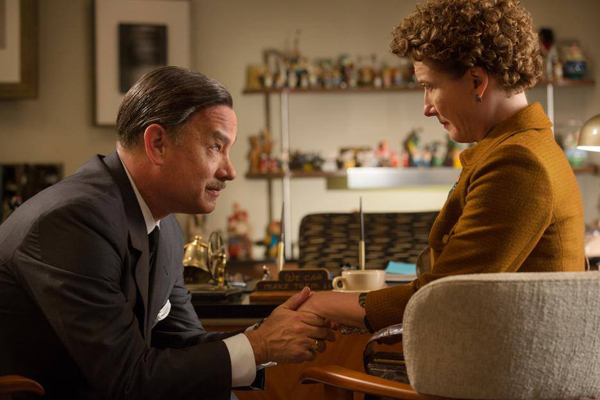Sometimes promises can’t be kept
Swift shot: A story about a wonderfully complicated woman and a man who wouldn’t hear “no.” Watching both Emma Thompson and Tom Hanks, two of my favorite actors, square off against one another was a real treat. I was secretly anxious that Hanks wouldn’t be able to pull off Walt Disney, as they are both my personal heroes for different reasons. I should never have doubted Hanks for a second. Paul Giamatti provides proof to the Stanislavsky quote, “there are no small parts, only small actors,” as he masterfully cements the film together with very few lines required.
Imagine telling Walt Disney, “No!” – before all the theme parks went up across the world, there was just the magical Disneyland in California and Walt Disney Studios. Known for Mickey Mouse and cartoons world-wide, Walt Disney (Tom Hanks) fascinated millions of people with his wonderful stories and endearing charm. P. L. Travers (Emma Thompson) was not one of those people.
Set in the early 60s, while Walt was busy working on “The Florida Project” – he was also desperate to keep a twenty year promise to his daughters, to bring their beloved child-hood fantasy character, Mary Poppins, to life. If you know a little about Walt (as he insisted on being called) you know he struggled early on with losing rights to Oswald the Lucky Rabbit, and what I didn’t know, but learned in the film, was he almost lost Mickey Mouse as well! So, he was very understanding of Travers not wanting to give her character away – he personally went through what he was now putting her through. For twenty years, I might add. But, finally, money, ever the villain in Travers’ life, comes knocking on her flat, and she reluctantly agrees to meet with Walt and his team in California.
The Marry Poppins creative team of, Robert Sherman (B.J. Novak), Richard Sherman (Jason Schwartzman), and Don DaGradi (Bradley Whitford) are immediately taken aback when they meet Ms. Travers (as she insisted on being called) because they are plucky and upbeat where she is clearly trying to be such a pain in the neck that they (and Walt) will just give up and toss the whole idea. Her Disney assigned chaeffeur, Ralph (Paul Giamatti) is an affable character that refuses to allow Travers’ dour gloom to bring him down.
As Travers reminisces on her life in Australia, the film methodically transitions from her past to the present, as we see glimpses of how Mary Poppins came to life. If you are a huge Mary Poppins fan, this may shatter you, but sometimes we need to see the truth to understand the fantasy. Her father, played by Colin Farrell, struggled with money and alcohol his whole life, and when you meet the real Mary Poppins, you’ll understand why sometimes promises just can’t be kept.
The Australia sequences, where Ms. Travers is flashing-back to her childhood are lacking exposition, but this is by design by Director John Lee Hancock, as she is remembering her childhood. Rarely are streams of dialogue recalled when you think back that far, so the audience is given only thematic perception to understand what is really going on in the scenes . . . again, through the eyes of a child.
With carefully placed homages to Mary Poppins throughout the film, and seeing the creative process of the composers and writers unfold, and seeing a side to Walt that few really knew existed, Saving Mr. Banks may just break your heart and also remind you that tragedy finds us all, but what you do afterwards is what makes a life interesting. Yes, even, and especially Walt Disney. I know some people that “hate Disney” – and I wish I could force them to watch this film, as it is really an invitation to take a second look at the man, the mouse, and the magic. And if they still say “No!” – why – just tell them to GO FLY A KITE!




